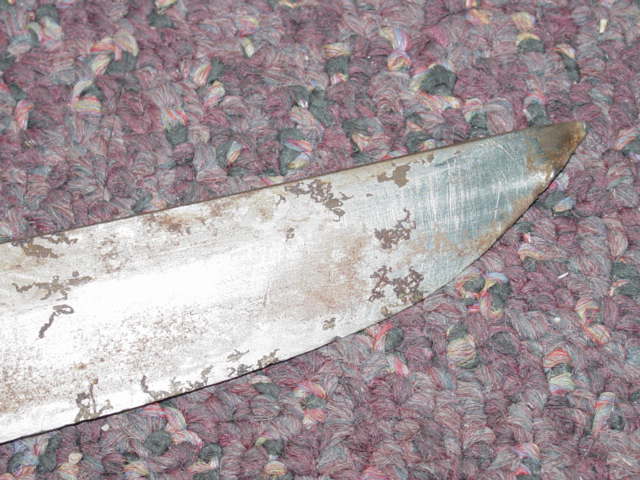
The blade shows some surface rusting and minor pitting to the edge. The temper line is not easily seen.
It is important for sword owners to learn how to properly handle blades in order to avoid costly damage
and value reduction. Some tips on how to handle Samurai blades include:
- DO not touch the blade. The hand contains oils that are damaging to the blade. Your fingerprints can be edged
into it.
- Store in a dry place. Avoid placing in basements. They tend to retain humidity, potentially causing water damage.
- Clean the blade with a soft cotton rag.
The Tang is not signed. Original rust still found. Never remove the rust because it helps
identify the age of the blade. The size and shape of the Tang can also give an indication
of the school that produced the blade.

|
This page is a recognition and identification guide for Samurai swords.
Multiple detailed photos of a specific sample are provided. Descriptions point
out clearly defined points that should be noted.
One of the most commonly asked questions is "How much is my Samurai Sword worth?".
A price guide is included here to address this question. The value of the swords is
reviewed over a period of several years. A trend can be observed. The present worth
of the edge weapons in the collector's market is illustrated.
This service is provided free of charge to the visitor/enthusiast courtesy of
MilitaryItems.com,
a company dedicated to the preservation of military history and to providing quality
military antiques and collectibles to museums, institutions and the general public.
|
|

The tip shows some wear. The rust is likely to be a byproduct of improper storage. The rest
ripling effect could have been caused by use. The blade has lost the Hamon. These marks
were the signature of the swordsmith that created the blade.
Polishing may bring back some of the original characteristics of the blade. Polishing should
be performed by a person with the proper training.

This Samurai Sword may be currently reproduced.
It is becoming more difficult to be able to tell the fake ones from the real ones because
the quality of the reproductions is improving. The collector must become familiarized with
the construction style and materials employed in the manufacturing of this item.
Attention to the details is critical in order to be able to determine the authenticity of
the collectible.
If you have an interest is seeing other Japanese Samurai swords, you can do so by going to our
Japanese Samurai Swords Price Guide
identification guide. Where we cover Samurai swords from all periods.
| 




